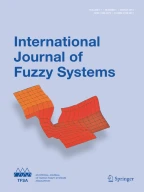Abstract
Recently, the study of chaotic behaviors in the social sciences includes the habit and the mind of human can be represented using models which include addiction, happiness, family relationship, and love. Within this field, various forms of love model have widely been studied. One of the most famous love models is the Romeo and Juliet model. To generate chaotic behaviors in the love model of Romeo and Juliet, it is necessary to apply an external force that is organized by a periodic function such as sine or cosine wave, which we assume as an ideal external force. However, because this ideal external force cannot possibly represent the real mind of a human, we need to find a reasonable function that allows us to closely describe the mind of human. In this paper, we propose a function that can describe the mind of human by using fuzzy membership function. To do this, we use Gaussian, sigmoid, and triangular fuzzy membership function as external forces. In order to get nonlinear behaviors by using computer simulation, we fix three parameters (a, c, and d) and vary parameter (b) for love model of Romeo and Juliet with the external forces of Gaussian, sigmoid, and triangular fuzzy membership function. Finally, we find that the external force that represents the nonlinear behaviors in love model of Romeo and Juliet through time series and phase portraits most excellent manner is the triangular fuzzy membership function.
Similar content being viewed by others
Explore related subjects
Discover the latest articles, news and stories from top researchers in related subjects.References
Wang, C., Chen, C.: Intelligent chaos synchronization of fractional order systems via mean-based slide mode controller. Int. J. Fuzzy Syst. 17(2), 144–157 (2015). doi:10.1007/s40815-015-0030-7
Bae, Y.: Chaotic phenomena in addiction model for digital leisure. Int. J. Fuzzy Log. Intell. Syst. 13(4), 291–297 (2013). doi:10.5391/IJFIS.2013.13.4.291
Kim, M., Bae, Y.: Mathematical modeling and chaotic behavior analysis of cyber addiction. J. Korean Inst. Intell. Syst. 24(3), 245–250 (2014). doi:10.5391/JKIIS.2014.24.3.245
Bae, Y.: Chaotic dynamics in tobacco’s addiction model. Int. J. Fuzzy Log. Intell. Syst. 14(4), 322–331 (2014). doi:10.5391/IJFIS.2014.14.4.322
Bae, Y.: Mathematical modeling and behavior analysis of addiction of physical exercise. J. Korean Inst. Intell. Syst. 24(6), 615–621 (2014). doi:10.5391/JKIIS.2014.24.6.615
Sprott, J.C.: Dynamical models of happiness. Nonlinear Dyn. Psychol. Life Sci. 9(1), 23–34 (2005)
Sprott, J.C.: Dynamics of Love and Happiness. Chaos and Complex Systems Seminar, Madison (2001)
Kim, S., Choi, S., Bae, Y., Park, Y.: Mathematical modeling of happiness and its nonlinear analysis. J. Korea Inst. Electr. Commun. Sci. 9(6), 711–717 (2013). doi:10.13067/JKIECS.2014.9.6.711
Bae, Y.: Synchronization of dynamical happiness model. Int. J. Fuzzy Log. Intell. Syst. 14(2), 91–97 (2014). doi:10.5391/IJFIS.2014.14.2.91
Huang, L.Y., Bae, Y.: Analysis of nonlinear dynamics in family model. J. Korean Inst. Intell. Syst. 25(4), 313–318 (2015). doi:10.5391/JKIIS.2015.25.4.313
Huang, L.Y., Bae, Y.: Analysis of nonlinear dynamics in family model including parent-in law. J. Korean Inst. Intell. Syst. 26(1), 37–43 (2016). doi:10.5391/JKIIS.2016.26.1.037
Strogatz, S.H.: Love affairs and differential equations. Math. Mag. 61, 35 (1988). doi:10.2307/2690328
Strogatz, S.H.: Nonlinear Dynamics and Chaos: With Application to Physics, Biology, Chemistry and Engineering. Addison-Wesley, Reading (1994)
Kim, S., Shon, Y., Bae, Y.: Mathematical modeling of love and its nonlinear analysis. J. Korea Inst. Electr. Commun. Sci. 9(11), 1297–1303 (2014). doi:10.13067/JKIECS.2014.9.11.1297
Bae, Y.: Behavior analysis of dynamic love model with time delay. J. Korea Inst. Electr. Commun. Sci. 10(2), 253–260 (2015). doi:10.13067/JKIECS.2015.10.2.253
Bae, Y.: Modified mathematical modeling of love and its behavior analysis. J. Korea Inst. Electr. Commun. Sci. 9(12), 1441–1446 (2014). doi:10.13067/JKIECS.2014.9.12.1441
Huang, L.Y., Bae, Y.: Behavior analysis in love model of Romeo and Juliet with time delay. J. Korean Inst. Intell. Syst. 25(2), 155–160 (2015). doi:10.5391/JKIIS.2015.25.2.155
Huang, L.Y., Bae, Y.: Comparative behavior analysis in love model with same and different time delay. J. Korean Inst. Intell. Syst. 25(3), 210–216 (2015). doi:10.5391/JKIIS.2015.25.3.210
Bae, Y.: Nonlinear behavior in love model with discontinuous external force. Int. J. Fuzzy Log. Intell. Syst. 16(1), 64–71 (2016). doi:10.5391/IJFIS.2016.16.1.64
Bae, Y.: Chaotic behavior in dynamic love model with different external force. Int. J. Fuzzy Log. Intell. Syst. 15(4), 283–288 (2015). doi:10.5391/IJFIS.2015.15.4.283
Hyang, L., Bae, Y.: Analysis of nonlinear behavior in love model with external force. J. Korea Inst. Electr. Commun. Sci. 10(7), 845–850 (2015). doi:10.13067/JKIECS.2015.10.7.845
Rinaldi, S.: Laura and Patriarch: an intriguing case of cyclical love dynamics. SIAM J. Appl. Math. 58, 1205–1221 (1998). doi:10.1137/S003613999630592X
Breitenecker, F., Judex, F., Popper, N., Breitenecker, A.: Love emotions between Laura and Petrarch: an approach by mathematics and system dynamics. J. Comput. Inf. Technol. 16(4), 255–269 (2008). doi:10.2498/cit.1001393
Wauer, J., Schwarzer, D., Cai, G.Q., Lin, Y.K.: Dynamical models of love with time-varying fluctuations. Appl. Math. Comput. 188(2), 1535–1548 (2007). doi:10.1016/j.amc.2006.11.026
Rinaldi, S.: Love dynamics: the case of linear couples. Appl. Math. Comput. 95(2–3), 181–192 (1998). doi:10.1016/S0096-3003(97)10081-9
Liao, X., Ran, J.: Hopf bifurcation in love dynamical models with nonlinear couples and time delays. Chaos Solitons Fractals 31(4), 853–865 (2007). doi:10.1016/j.chaos.2005.10.037
Ahmad, W.M., E-Khazali, R.: Fractional-order dynamical model of love. Chaos Solitons Fractals 33(4), 1367–1375 (2007). doi:10.1016/j.chaos.2006.01.098
Ahmad, W.L., Chen, K.: Chaotic behavior in a new fractional-order love triangle system with competition. Appl. Anal. Comput. 5(1), 103–113 (2015)
Cresswell, C.: Mathematics and Sex. Griffin Press, Syndey (2003)
Huang, L., Hwang, S., Bae, Y.: Chaotic behavior in model with a Gaussian function as external force. Int. J. Fuzzy Log. Intell. Syst. 16(4), 262–269 (2016). doi:10.5391/IJFIS.2016.16.4.262
Author information
Authors and Affiliations
Corresponding author
Rights and permissions
About this article
Cite this article
Huang, L., Bae, Y. Nonlinear Behavior in Romeo and Juliet’s Love Model Influenced by External Force with Fuzzy Membership Function. Int. J. Fuzzy Syst. 19, 1670–1682 (2017). https://doi.org/10.1007/s40815-017-0346-6
Received:
Revised:
Accepted:
Published:
Issue Date:
DOI: https://doi.org/10.1007/s40815-017-0346-6
